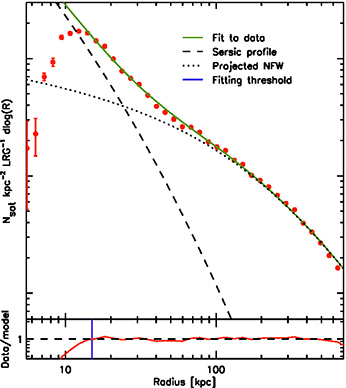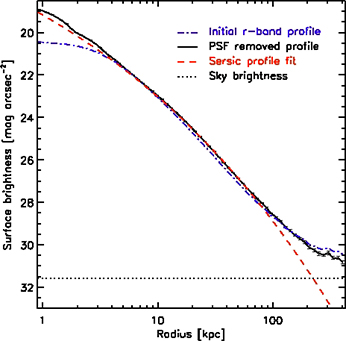|
Observations of environmental quenching in groups in the 11 Gyr since z=2.5: different quenching for central and satellite galaxies |
with A. Dekel, P. Oesch, A. Muzzin, G. Brammer, P. van Dokkum, M. Franx, G. Illingworth, J. Leja, D. Magee, D. Marchesini, I. Momcheva, E. Nelson, S. Patel, R. Quadri, H-W Rix, R. Skelton, D. Wake and K. Whitaker |
|
|
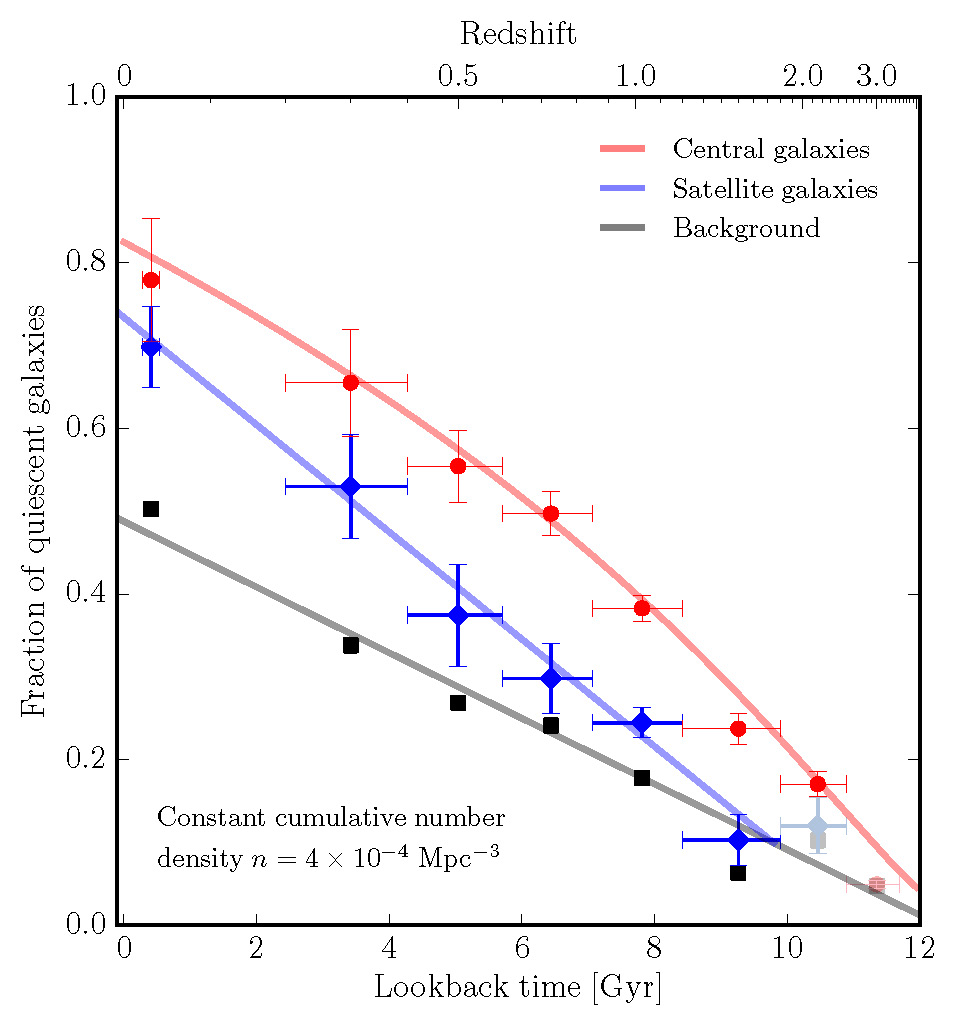
Environmental quenching in groups. The observed quenching rate and onset of satellite galaxies compared to their centrals and to background galaxies at the same mass and redshift imply that star formation in satellites is affected by environmental processes. |
We present direct observational evidence for star formation quenching in galaxy groups in the redshift range 0<z<2.5. We utilize a large sample of nearly 6000 groups, selected by fixed cumulative number density from three photometric catalogs, to follow the evolving quiescent fractions of central and satellite galaxies over roughly 11 Gyr. At z~0, central galaxies in our sample range in stellar mass from Milky Way/M31 analogs (M★/M⊙=6.5×1010) to nearby massive ellipticals (M★/M⊙ = 1.5×1011). Satellite galaxies in the same groups reach masses as low as twice that of the Large Magellanic Cloud (M★/M⊙=6.5×109). Using statistical background subtraction, we measure the average rest-frame colors of galaxies in our groups and calculate the evolving quiescent fractions of centrals and satellites over seven redshift bins. Our analysis shows clear evidence for star formation quenching in group halos, with a different quenching onset for centrals and their satellite galaxies. Using halo mass estimates for our central galaxies, we find that star formation shuts off in centrals when typical halo masses reach between 1012 and 1013 M⊙, consistent with predictions from the halo quenching model. In contrast, satellite galaxies in the same groups most likely undergo quenching by environmental processes, whose onset is delayed with respect to their central galaxy. Although star formation is suppressed in all galaxies over time, the processes that govern quenching are different for centrals and satellites. While mass plays an important role in determining the star formation activity of central galaxies, quenching in satellite galaxies is dominated by the environment in which they reside. |
|
Galaxy environments over cosmic time: the non-evolving radial galaxy distributions around massive galaxies since z = 1.6 |
with P. van Dokkum, M. Franx, J. Leja, D. Wake and K. Whitaker |
|
|
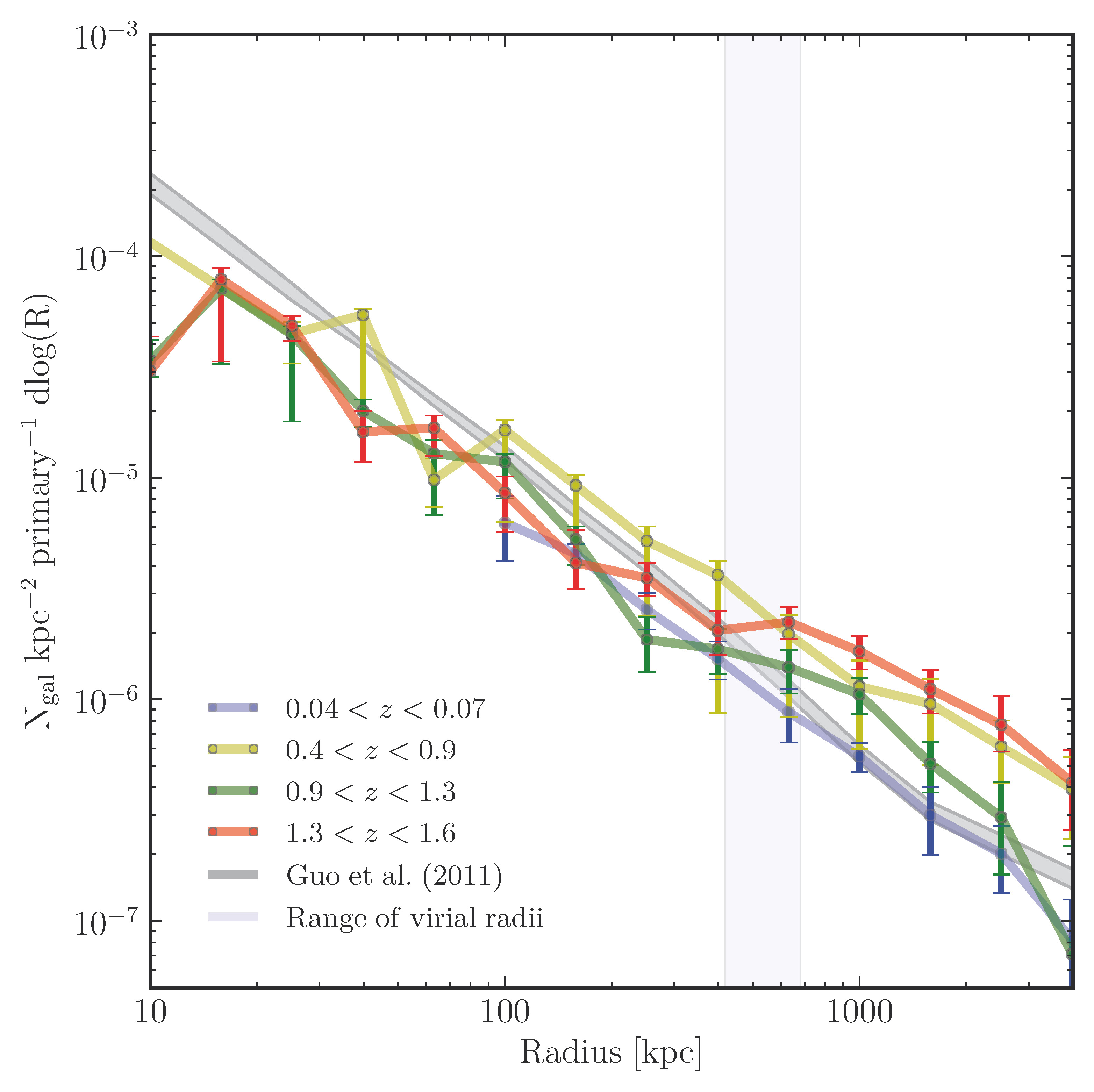
Projected radial profile of galaxies around the selected primaries in four redshift bins (colored lines). The profiles show a remarkable lack of evolution in the radial galaxy distribution since z = 1.6. |
We present a statistical study of the environments of massive galaxies in four redshift bins between z = 0.04 and z = 1.6, using data from the Sloan Digital Sky Survey and the NEWFIRM Medium Band Survey. We measure the projected radial distribution of galaxies in cylinders around a constant number density selected sample of massive galaxies and utilize a statistical subtraction of contaminating sources. Our analysis shows that massive primary galaxies typically live in group halos and are surrounded by 2–3 satellites with masses more than one-tenth of the primary galaxy mass. The cumulative stellar mass in these satellites roughly equals the mass of the primary galaxy itself. We further find that the radial number density profile of galaxies around massive primaries has not evolved significantly in either slope or overall normalization in the past 9.5 Gyr. A simplistic interpretation of this result can be taken as evidence for a lack of mergers in the studied groups and as support for a static evolution model of halos containing massive primaries. Alternatively, there exists a tight balance between mergers and accretion of new satellites such that the overall distribution of galaxies in and around the halo is preserved. The latter interpretation is supported by a comparison to a semi-analytic model, which shows a similar constant average satellite distribution over the same redshift range. |
Mass growth and mergers: direct observations of the luminosity function of LRG satellite galaxies out to z=0.7 |
with D. Wake, P. van Dokkum, F. van den Bosch, D. Schneider, J. Brinkmann and B. Weaver |
|
|
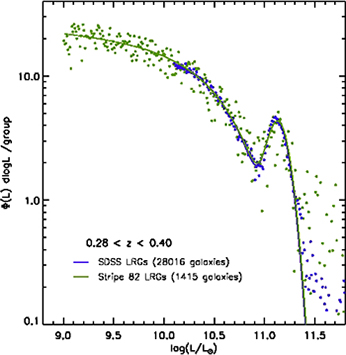
Comparison between the luminosity functions derived from individual SDSS LRG frames (blue data points) and from deep Stripe 82 stacks (green data points) in the redshift range 0.28<z<0.40. |
We present a statistical study of the luminosity functions of galaxies surrounding luminous red galaxies (LRGs) at average redshifts z=0.34 and z=0.65. The luminosity functions are derived by extracting source photometry around the LRGs and subtracting foreground and background contamination using randomly selected control fields. We show that at both studied redshifts the average luminosity functions of the LRGs and their satellite galaxies are poorly fitted by a Schechter function due to a luminosity gap between the centrals and their most luminous satellites. We utilize a two-component fit of a Schechter function plus a log-normal distribution to demonstrate that LRGs are typically brighter than their most luminous satellite by roughly 1.3 magnitudes. This luminosity gap implies that interactions within LRG environments are typically restricted to minor mergers with mass ratios of 1:4 or lower. The luminosity functions further imply that roughly 35% of the mass in the environment is locked in the LRG itself, supporting the idea that mass growth through major mergers within the environment is unlikely. Lastly, we show that the luminosity gap may be at least partially explained by the selection of LRGs as the gap can be reproduced by sparsely sampling a Schechter function. In that case LRGs may represent only a small fraction of central galaxies in similar mass halos. |
The frequency of tidal features in nearby elliptical galaxies |
with P. van Dokkum, J. Nelan, R. Bezanson |
|
|
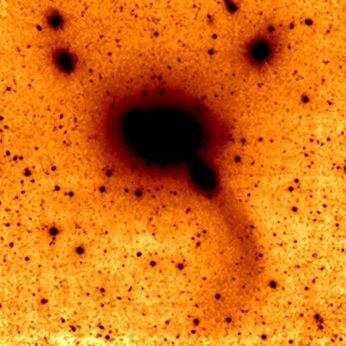
NGC 5576 and its companion exhibit an 11' (85 kpc) long tidal tail. The excellent flat-fielding properties and the depth of the data exposed tidal features in ~74% of the sample galaxies.
The OBEY survey |
We present a deep broadband optical imaging study of a complete sample of luminous elliptical galaxies (MV<-20) at distances 15 Mpc - 50 Mpc, selected from the Tully catalog of nearby galaxies. The images are flat to ~0.35% across the 20' field and reach a depth of 27.7 mag arcsec-2. We derive an objective tidal interaction parameter for all galaxies and find that 73% of them show tidal disturbance signatures in their stellar bodies. This is the first time that such an analysis is done on a statistically complete sample and it confirms that tidal features in ellipticals are common even in the local Universe. From the dynamical time of the sample galaxies at the innermost radius where tidal features are detected we estimate the mass assembly rate of nearby ellipticals to be dM/M~0.2 per Gyr with large uncertainty. We explore the relation between gravitational interaction signatures and the galaxy environment and find that galaxies in clusters are less disturbed than group and field galaxies. We also study how these interactions affect the broadband colors of ellipticals and find a moderate correlation, suggesting that the mergers are not accompanied by significant star-formation. Lastly, we find no correlation between AGN activity, as measured by 6cm radio emission, and large scale tidal distortions. This implies that gravitational interactions are not the only, and perhaps not the most important, trigger of nuclear activity. In summary, we find that elliptical galaxies in groups and low density environments continue to grow at the present day through ``dry'' mergers involving little star formation. |



